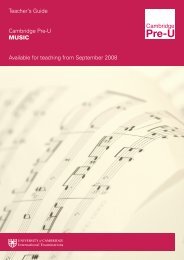Cambridge Pre-U Syllabus - Cambridge International Examinations
Cambridge Pre-U Syllabus - Cambridge International Examinations
Cambridge Pre-U Syllabus - Cambridge International Examinations
Create successful ePaper yourself
Turn your PDF publications into a flip-book with our unique Google optimized e-Paper software.
<strong>Cambridge</strong> <strong>Pre</strong>-U <strong>Syllabus</strong><br />
1.6 Genes and protein synthesis<br />
Content<br />
The gene and genetic code<br />
Protein synthesis<br />
Control of gene expression<br />
Inheritance and Mendelian genetics<br />
Mutations<br />
Genetic conditions<br />
Learning outcomes<br />
Candidates should be able to:<br />
a) define a gene as a unit of inheritance or as an ordered sequence of nucleotides located at a particular<br />
locus on a particular chromosome which codes for a particular protein, or in certain cases a functional or<br />
structural RNA molecule. Discuss the limitations of the latter definition with reference to introns, exons<br />
and promoters<br />
b) describe the genetic code and discuss the extent to which it is true that the code is universal to all<br />
organisms<br />
c) explain protein synthesis in terms of transcription and translation including the roles of DNA, mRNA,<br />
tRNA and ribosomes<br />
d) describe, in outline, eukaryotic introns, exons and the splicing of mRNA<br />
e) define the term proteomics and outline its importance to biomedicine (limited to diagnosis and drug<br />
design)<br />
f) describe, in outline, the control of gene expression (limited to the lac operon in prokaryotes)<br />
g) state, with examples, the differences between continuous and discontinuous variation (limited to relative<br />
number of genes and alleles involved and relative impact of the environment as well as relative range of<br />
phenotypes)<br />
h) define and use the terms allele, locus, phenotype, genotype, dominant, recessive and codominant<br />
i) use genetic diagrams to solve dihybrid crosses, including those involving sex linkage, autosomal<br />
linkage, epistasis, codominance and multiple alleles<br />
j) use and interpret the chi-squared test to test the significance of the difference between observed and<br />
expected results. (The formula for the chi-squared test will be provided.)<br />
k) explain that the effects of ionising radiation on living cells can have a range of outcomes including DNA<br />
damage which is repaired, DNA damage that cannot be repaired, leading to apoptosis, and DNA<br />
damage causing mutations. Mutations that do not kill the cell but are passed on to its descendants<br />
during cell division (including mutations that can cause cancer e.g. those that cause proto-oncogenes to<br />
become oncogenes and those that reduce the activity of tumour-suppressor genes)<br />
l) describe gene mutations, limited to substitution, deletion and insertion<br />
m) explain, with reference to sickle cell anaemia, cystic fibrosis and hereditary haemochromatosis, how<br />
gene mutations might affect expression of a protein and thus affect phenotype (issues related to genetic<br />
conditions need to be handled with sensitivity)<br />
n) describe the causes and outline the symptoms of hereditary haemochromatosis (HH) as an example of<br />
a recessive genetic condition (reference should be made to HFE protein)<br />
21

















